
There’s something thrilling about getting off a plane and knowing that in just a few hours, you’ll be surrounded by some of the most breathtaking birds on the planet. That’s exactly what you can expect when you land in San José, Costa Rica, and start your drive to San Gerardo de Dota. Trust me, it’s worth every twist and turn…, even the near-death defying experiences with the Costa Ricans drivers!
San Gerardo de Dota is tucked away in the Talamanca Mountains, a serene valley cradled by towering peaks and cloud forests, it’s about 3 hrs by car from the San Jose International Airport. This is not just any birding destination, it’s paradise for anyone with binoculars, a camera, or just a love for feathered wonders.
And sure, San Gerardo de Dota is famous for the Resplendent Quetzal, yes, the one with the impossible to miss long green feathers, but let’s dive into some of the other birds that deserve attention as well. And no, I won’t mention the Trogon either, because who needs the obvious choice when there’s so much more on offer?
Golden-Browed Chlorophonia: A name like Chlorophonia sounds as exotic as this bird looks.
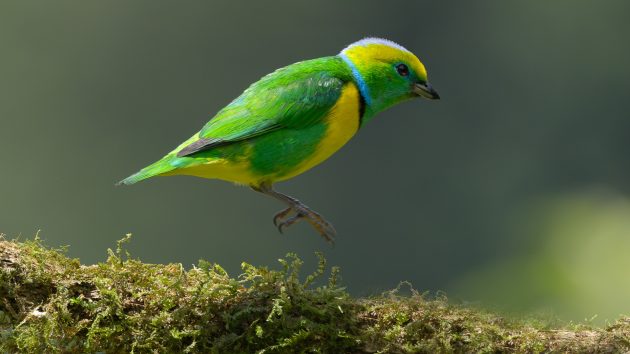
The male sports a bright green, yellow, black and blue colour, with both male and female also having a violet-blue cap. This is one of those birds that make you appreciate how vibrant nature can be.

If you’re lucky, you’ll catch one bouncing between the trees, a little dash of tropical color against the greenery.
Long-tailed Silky-flycatcher: These elegant birds move through the forest with effortless grace, their sleek, silky feathers flowing as they flit from branch to branch.

Their name might be a mouthful, but spotting one is a sight for sore eyes and a treat for your camera. Fortunately, they seemed to not have much fear of humans and were ever present around the lodge feeding on these yellow berries.
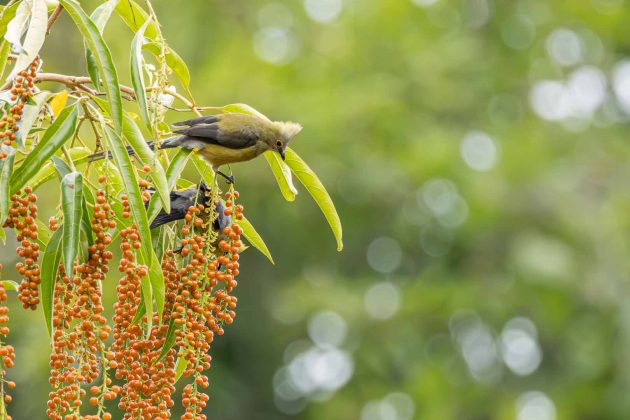
Talamanca Hummingbird: This glittering gem seems to always be in a hurry, zipping around flowers like it’s late for a very important date, and very stern looking too.

It’s found in the high-altitude regions of Costa Rica and western Panama and is a member of the “mountain gems” tribe of hummingbirds, it is known for its vibrant and distinctive appearance.
The Scintillant Hummingbird: This is a tiny marvel of nature, found exclusively in the mountains of Costa Rica and western Panama.

Hummingbirds are generally small, but this one has to be the smallest I have ever seen so far.
Lesser Violetear: Known for the distinctive violet patches on its ears (yes, birds with ears!), this hummingbird is another frequent visitor around the local lodges.

It’s one of those birds that when it flares its feathers, it looks like it belongs in a fantasy novel, but no, this is real life in San Gerardo de Dota.
While observing this bird I realised that it would flare the violet feathers whenever another bird came close, perhaps to warn them off or attract the females.
The Acorn Woodpecker: This is a captivating bird that brings a splash of color and a touch of whimsy to the cloud forests of Costa Rica.

Imagine a medium-sized woodpecker, about 20 centimeters long, with a striking appearance that makes it easy to spot. Its head is adorned with a vibrant red cap, contrasting sharply with its white forehead and throat. The rest of its body is a glossy black, with white patches on its wings and rump that flash brilliantly when it takes flight.
The Silver-Throated Tanager: Tanagers are like the colorful jewels of the forest, and the Silver-throated Tanager is no exception. If you have read my article on “My 7 Favourite birds of the Americas and Caribbean” you will know that Tanagers are one of my favourite birds.

The silver and yellow plumage of Sliver-throated Tanager is striking, especially when you see it set against the deep greens of the cloud forest.

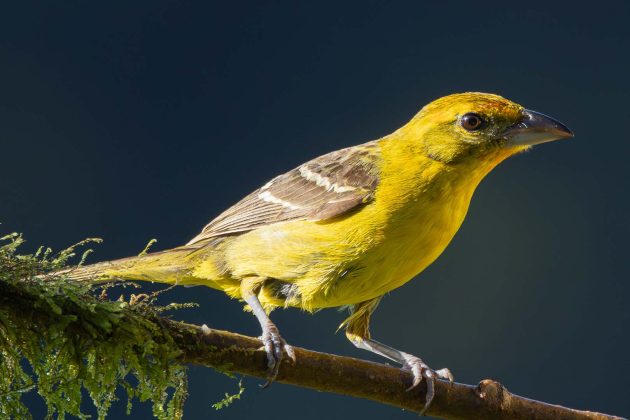


Black-thighed Grosbeak: This bird showed up one morning just outside our cottage.

The Rufous-collared Sparrow: This may not be as flashy as some of the other birds here, but it’s charming in its own right.

With its distinctive rusty neck and melodic song, it’s a reminder that even the more subtle birds have something special to offer.
The Flower-piercer: A strange looking bird the first time you lay your eyes on it. They have a unique and fascinating feeding behaviour that sets them apart from other nectar-feeding birds.

Unlike hummingbirds, which sip nectar directly from the flower, flower-piercers use their specialized bills to pierce the base of the flower allowing them to reach the nectar without having to enter the flower itself. While this behavior may seem a little sneaky, you can’t help but admire its cleverness.

The Yellowish Flycatcher: Small and unassuming, it is an expert at darting through the canopy, catching insects mid-air.
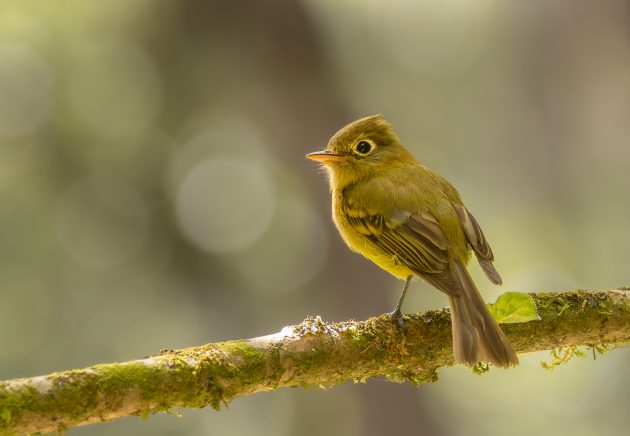
It’s the kind of bird you could easily overlook, but once you spot one, you’ll notice its soft yellow hues and calm demeanor. This particular one just sat there and seemed to be observing me instead of the other way around as its eyes followed my every move.
The Chestnut-capped Brushfinch: I was overjoyed when I first saw this bird, it had been described to me by a fellow birder not long before and may have possibly been the very same bird as I saw it in much the same location as was mentioned. It’s a secretive bird and quite elusive so I felt lucky having seen it.

The Black Guan: A big chicken like bird found in Costa Rica and western Panama, is easily recognized by its all-black plumage, bright blue facial skin, and red eyes. Preferring the cloud forests of the Talamancan mountains, it thrives at elevations between 1,000 and 2,250 meters.

This bird primarily feeds on fruits, playing a crucial role in seed dispersal. Typically seen alone or in small groups, the black guan is mostly sedentary but may move seasonally.
The Sooty-Capped Chlorospingus: This small tanager like sparrow came into view on one of my early morning trips, high up on a dead branch and through the early morning fog I was surprised that I managed to spot it.
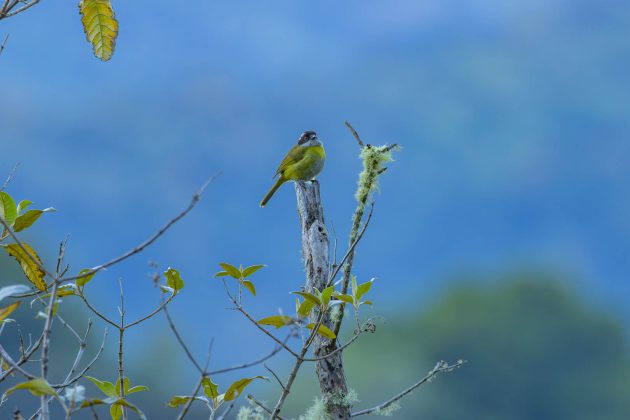
Ruddy-capped Nightingale-Thrush: A small bird thats not easy to spot as it feeds mainly on the ground and blends in with the dried leaves etc. This one was observed late morning along the private trail of one of the lodges in the area.

Spotted Wood-Quail: On our way to breakfast one morning, about 5 meters from our cottage a group of these Spotted Wood-Quails were seen foraging on the ground. They paid very little attention to us as we walked past.

San Gerardo de Dota offers an unparalleled birding experience, where the vibrant colors and melodic calls of countless bird species create a symphony of nature. Whether you’re a seasoned birder or a curious traveler, the lush cloud forests and serene landscapes of this Costa Rican gem promise unforgettable encounters and lasting memories. So pack your binoculars, embrace the adventure, and let the avian wonders of San Gerardo de Dota captivate your soul. Happy birding!.









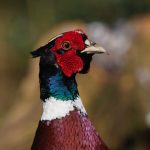



Beautiful birds, great photos, and a reminder for me to go to Costa Rica sooner rather than later.
It’s 30 years since I last visited Costa Rica – Fitzroy’s lovely article brought back happy memories (and I never did see a Spotted Wood-Quail, so perhaps I should go back).
We went to Costa Rica in 2018. Our guide took us to San Gerado de Dota. We saw all the species you saw. It was a magical place. Thanks for bringing back some wonderful memories. Great photos!
Wow, what an enchanting article! Your vivid description of San Gerardo de Dota brings the cloud forest to life, especially with the variety of birds like the Golden-Browed Chlorophonia, and the Long-tailed Silky-Flycatcher. The way you capture the beauty and behaviour of each species makes me want to pack my binoculars and head to Costa Rica! Thanks for sharing such a detailed and inspiring journey. The photos were stunning, too!
An exhilarating read with a thrilling explanation of the different avian species captured in their natural habitat. I have toured throught the rain forests and cloud forests both night and day several times in the past, however it was at a period when my personal pasion for photography was at an all time low, however now restored I shall have to revisit this beautiful country once again.